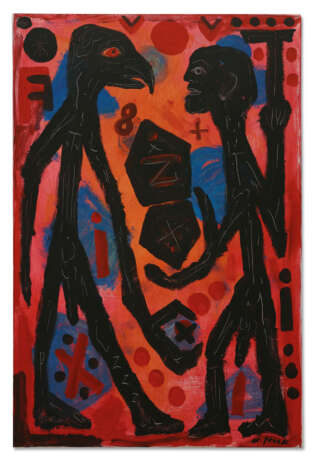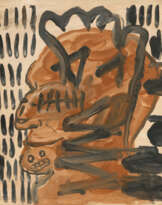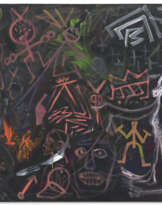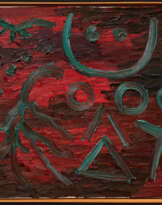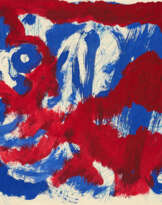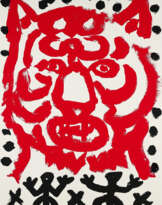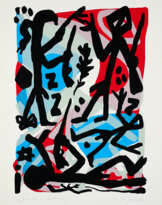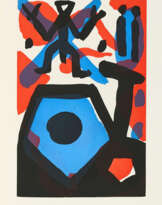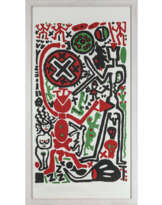ID 813927
Lot 51 | A. R. Penck (1939-2017)
Estimate value
€ 100 000 – 150 000
Begegnung II
signé 'ar. penck' (en bas à droite)
acrylique sur toile
150 x 100 cm.
Peint en 1996.
signed 'ar. penck' (lower right)
acrylic on canvas
59 x 39 3/8 in.
Painted in 1996.
Provenance
Galerie Jérôme de Noirmont, Paris
Acquis auprès de celle-ci en 1998
Exhibited
Paris, Galerie Jérôme de Noirmont, La mort du temps, septembre-novembre 1996, No. 21 (illustré en couleurs au catalogue d'exposition).
Special notice
Artist's Resale Right ("droit de Suite").
If the Artist's Resale Right Regulations 2006 apply to this lot, the buyer also agrees to pay us an amount equal to the resale royalty provided for in those Regulations, and we undertake to the buyer to pay such amount to the artist's collection agent.
This item will be transferred to an offsite warehouse after the sale. Please refer to department for information about storage charges and collection
details.
Post lot text
Né Ralf Winkler en 1939, Penck a adopté son nom d'artiste en 1963 lorsqu'il a quitté sa ville natale de Dresde pour s'installer à Berlin-Est. Devenu célèbre aux côtés de ses collègues allemands Georg Baselitz, Jörg Immendorff et Markus Lüpertz, Penck est devenu un acteur clé du nouveau mouvement figuratif allemand des années 1970. L'artiste s’étant lié d'amitié avec Michael Werner en 1965, celui-ci a organisé une première exposition individuelle pour Penck en 1968, et a joué un rôle crucial dans la promotion de la place de l'artiste sur la scène artistique d'après-guerre. Considéré comme un artiste néo-expressionniste, la peinture et la sculpture de Penck s'inspirent de tableaux rupestres et des hiéroglyphes, illustrant des symboles et motifs primitifs et des figures en bâton. Il a donné le nom de « Standart » à cette technique, créant un langage visuel combinant texte, image et symboles.
En 1975, une première grande rétrospective a été consacrée à l'artiste à la Kunsthalle de Berne, et de nombreuses autres expositions personnelles ont eu lieu dans le monde entier depuis, ainsi que la participation à plusieurs éditions de Documenta et à la Biennale de Venise de 1984. L'œuvre de Penck est présente dans de nombreuses collections publiques importantes à travers le monde, dont le Museum of Modern Art de New York, la Tate Gallery de Londres et le Centre Pompidou de Paris.
Begegnung II, qui signifie « rencontre », est un bel exemple du style artistique unique de Penck. Exécutée en 1996, cette œuvre a été présentée lors de l'exposition La mort du temps en 1996 à la Galerie Jérome de Noirmont et comprend tous les éléments centraux de la technique de Penck.
Plus spécifiquement, l’emploi de la figure de l’aigle noir revêt une dimension à la fois éminemment personnelle, mais aussi et plus largement géopolitique. L’aigle symbolise en effet le pouvoir politique allemand, y compris dans ce qu’il a de plus autoritaire et menaçant. Victime lui-même de l’oppression de la Stasi, Penck met en scène par cette « rencontre » la confrontation de l’homme (à droite) et du symbole (à gauche). Ce faisant, l’œuvre est à relier d’une tradition picturale allemande cherchant à battre en brèche, après la Seconde Guerre mondiale et au cours de la seconde partie du XXème siècle, les mythes constructeurs de l’identité allemande. Ce faisant, elle rapproche Penck de certains de ses contemporains, notamment Georg Baselitz.
Born Ralf Winkler in 1939, Penck adopted his artist name in 1963 when he moved to East Berlin from his home city Dresden. Rising to prominence alongside fellow German artists Georg Baselitz, Jörg Immendorff and Markus Lüpertz, Penck became a key player in Germany’s new figurative movement of the 1970’s. The artist befriended Michael Werner in 1965, who organized a first solo exhibition for Penck in 1968, and played a crucial role in promoting the artists place in the post-war art scene. Considered a neo-expressionist artist, Penck’s painting and sculpture takes inspiration from cave paintings and hieroglyphs, illustrating primitive symbols and patterns and stick figures. He gave the name “Standart” to this technique, creating a visual language combining text, image and symbols.
In 1975, a first major retrospective was dedicated to the artist at the Bern Kunsthalle, and numerous other solo exhibitions have taken place all over the world since, as well as participating in several editions of Documenta and the 1984 Venice Biennale. Penck’s work is present in many important public collections across the globe, including the Museum of Modern Art in New York, the Tate Gallery in London and the Centre Pompidou in Paris.
Begegnung II, meaning “encounter”, is a fine example of Penck’s unique artistic style. Executed in 1996 this work was exhibited during the exhibition La mort du temps in 1996 at the Galerie Jérome de Noirmont and includes all the elements central to Penck’s technique.
More specifically, the use of the black eagle emblem has both an eminently personal and, more broadly, a geopolitical dimension. The eagle symbolises German political power, including its most authoritarian and threatening aspects. As a victim of Stasi oppression, Penck stages the confrontation between the man (on the right) and the symbol (on the left) in this "encounter."
In so doing, the work is linked to a German pictorial tradition which, after the Second World War and in the second half of the twentieth century, sought to undermine the myths that constructed German identity. Thus, it brings Penck closer to some of his contemporaries, notably Georg Baselitz.
| Artist: | A. R. Penck (1939 - 2017) |
|---|---|
| Art style: | Contemporary art |
| Place of origin: | Western Europe, Germany, Europe |
| Auction house category: | Paintings |
| Artist: | A. R. Penck (1939 - 2017) |
|---|---|
| Art style: | Contemporary art |
| Place of origin: | Western Europe, Germany, Europe |
| Auction house category: | Paintings |
| Address of auction |
CHRISTIE'S 9 Avenue Matignon 75008 Paris France | ||||||||||||||
|---|---|---|---|---|---|---|---|---|---|---|---|---|---|---|---|
| Preview |
| ||||||||||||||
| Phone | +33 (0)1 40 76 85 85 | ||||||||||||||
| Fax | +33 (0)1 40 76 85 86 | ||||||||||||||
| Conditions of purchase | Conditions of purchase | ||||||||||||||
| Shipping |
Postal service Courier service pickup by yourself | ||||||||||||||
| Payment methods |
Wire Transfer | ||||||||||||||
| Business hours | Business hours
|
